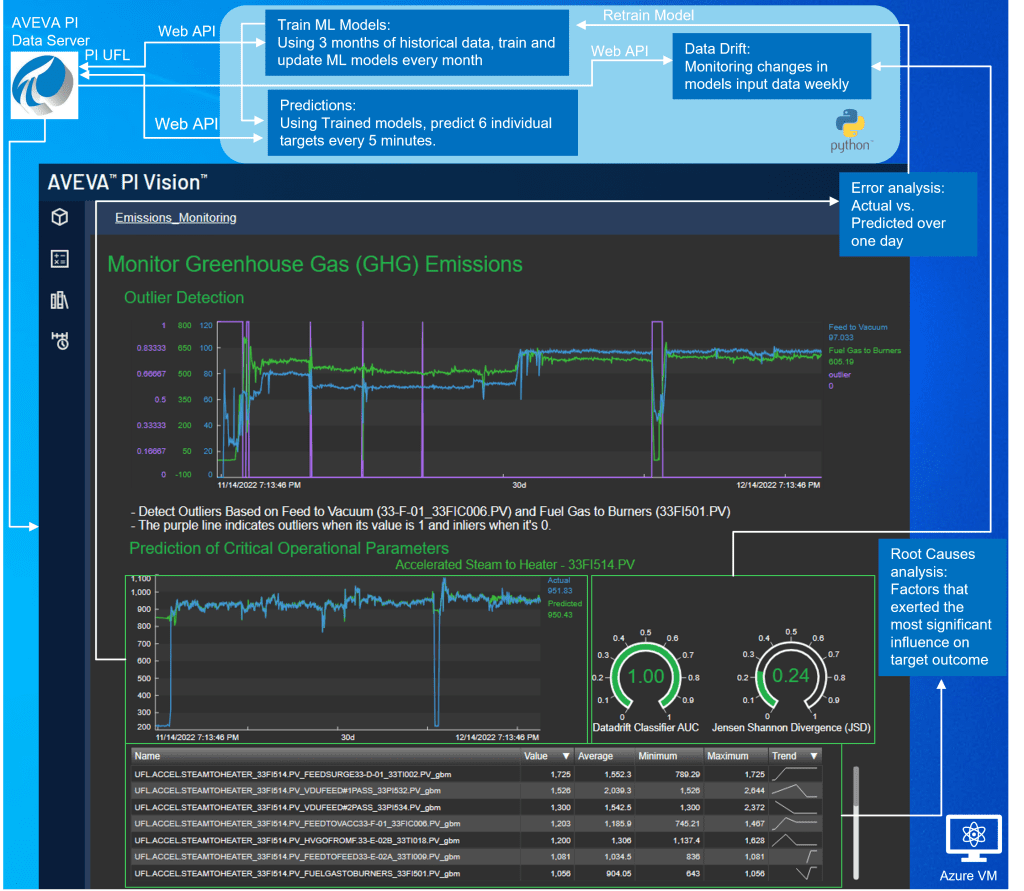Over the years, refinery-petrochemical plants have struggled to reduce their carbon emissions. Traditional monitoring methods lack immediate insights for proactive environmental improvement.
According to the U.S. Department of Energy, chemical production and refining contributed to approximately 11% of energy-related carbon dioxide (CO2) emissions in 2021. That amount equaled about 38% of all industrial energy-related CO2 emissions – equivalent to 1.5 times the total emissions of New York State.
Such emissions present significant health and environmental risks. Enhancing emissions monitoring is crucial to mitigate these harmful effects by providing the necessary data to identify, address, and reduce emissions in a timely manner. This will ultimately contribute to a cleaner and safer environment.

With recent advances in technology, we are able to empower operators to optimize processes and minimize carbon emissions. In a recent use case, Schneider Electric implemented a cutting-edge solution: a near real-time machine earning model customized to monitor six emission sources from a vacuum distillation unit.
This model provides instant insights into potential deviations in CO2 emissions, leveraging AVEVA PI integration to analyze data streams every five minutes. This empowers operators to respond promptly, investigate root causes, and make targeted adjustments to optimize processes and minimize CO2 emissions.
Vacuum distillation units are widely used across industries such as:
- Chemical and pharmaceutical production
- Crude oil refining (including the trend towards crude to chemicals production)
- Essential oil and fragrance manufacturing
- Food processing
- Thermal-based water production for ultrapure or desalinated water
The outlined approach is applicable across various industries. It aims to mitigate environmental impact while improving operational efficiency, and it’s not limited to vacuum distillation alone. The goal is to introduce a practical method applicable to diverse processes, contributing to a more sustainable future.
Predicting emissions with machine learning
To enable near real-time CO2 tracking, essential steps included:
- Validating operational data
- Benchmarking emissions performance
- Selecting a machine learning (ML) algorithm to predict emissions
- Flagging deteriorating performance
- Conducting root cause analysis
During the project execution phase, subject matter experts assisted with operational data validation and correction, while providing process understanding. Following this, data scientists focused on feature engineering, selecting ML algorithms, and identifying metrics.
Ultimately, a ML algorithm can predict critical operational parameters based on specific plant operation conditions.

In Figure 1 (above), outliers based on feed to vacuum and fuel gas to burners are initially identified. The outlier, an observation that lies an abnormal distance from other values in the dataset, is shown as the purple line with a value of 1. Inliers – a typical observation within the dataset – are represented with a value of 0.
We then trained the ML model on the cleaned data after removing outliers from historical data and used it to predict critical operational parameters every five minutes. In Figure 2 (below), some predicted KPIs aligned closely with measured results, indicating normal operations, while others showed significant deviations. These actions help us foresee potential issues.
Figure 2 also monitored data drift, reflecting changes in statistical properties over time, evaluated using the area under the curve (AUC) metric. An AUC near 0.5 suggests minimal drift, while closer to 1 indicates more significant drift. Jensen Shannon Divergence measures the impact of drift on model performance. These evaluations help ensure that the model remains accurate and reliable as operational conditions change over time.

Using machine learning to find deviations
In Figure 3, the ML model identifies key factors influencing the target outcome for root cause analysis of deviations. It continuously updates and ranks important features in real time, offering insights for emissions control decisions. The value signifies a feature’s significance, with a higher value indicating greater influence.
We also present the average, minimum, maximum, and trend of feature importance over time. Such data enables prompt intervention and opportunities to improve process control, performance, and emissions reduction.

Integrating an advanced ML model with the AVEVA PI system enables businesses to maximize their operational data’s potential. The integration offers actionable insights, as illustrated in Figure 4, to optimize process performance and enable data-driven decision-making. By using historical PI data, organizations can make real-time predictions to detect deviations and potential root causes. This leads to improved performance, reduced costs, and a competitive edge.
The integration process is simple and can be done in a few steps:
- Set up a virtual machine or cloud instance
- The PI system is configured for real-time data storage and notification management
- The Python environment is configured, and necessary files are created
- The PI Connector for Universal File and Stream Loader is set up to enable data ingestion from external sources into the AVEVA PI System
All of this ensures a seamless and efficient integration.

Optimize emissions monitoring
This use case showcases an innovative ML approach to reduce environmental impact in the energy and chemical industries. By integrating a sophisticated model with the AVEVA PI system, the project enabled:
- Development of a robust ML prediction model accurately forecasting emissions, enabling timely decision-making to avoid exceeding GHG emissions.
- Generation of process-related predictors for different chemical process units, offering a comprehensive understanding of specific process unit performance and facilitating timely adjustments.
- Seamless integration of the solution with AVEVA PI Vision, increasing visibility and accessibility of critical data. Reports on PI Vision also facilitate activities such as maintenance planning and provide management with easy access to GHG emissions problems.
The integration of the Emissions Monitoring Tool with AVEVA PI represents a step toward data-driven operations focused on sustainability and efficiency. This project highlights the potential of advanced technologies to address complex challenges and drive continuous improvement.
Stay tuned for more updates as we continue to push the boundaries of innovation in emissions monitoring and beyond. Find out how you can shape a greener and more sustainable future for your industrial operations.




Add a comment